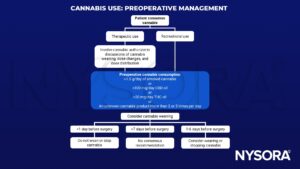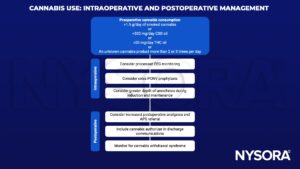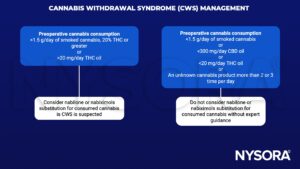Learning objectives
- Describe the mechanisms and clinical effects of cannabis
- Manage patients who consumed cannabis preoperatively
- Manage patients who present with cannabis withdrawal syndrome postoperatively
Background
- According to the United Nations, approximately 284 million individuals used cannabis in 2020
- This number is expected to grow as many countries are starting to legalize cannabis use
- The number of patients who use cannabis perioperatively will consequently rise
Mechanisms
- Tetrahydrocannabinol (THC) and cannabidiol (CBD) are the most studied cannabinoid constituents of cannabis
- THC is a cannabinoid receptor type 1 and type 2 partial agonist
- CBD is a negative allosteric modulator of the cannabinoid receptor
- Clinical effects of cannabis vary with the quantity and chronicity of its use
Clinical effects
| Acute | Chronic | |
|---|---|---|
| Cardiovascular | Tachycardia | Atheromatous disease |
| Vasodilation | ||
| Orthostasis | ||
| Pulmonary | Bronchodilation | Chronic bronchitis |
| Hyperreactivity | Emphysema | |
| Airway edema | ||
| Central nervous system | Anxiolysis | Similar to acute effects but tolerance develops, requiring higher doses for similar effects |
| Anxiety | ||
| Paranoia/psychosis | ||
| Euphoria | ||
| Dizziness | ||
| Headache | ||
| Memory dysfunction | ||
| Analgesia | ||
| Gastrointestinal | Antinausea | Hyperemesis |
| Increased appetite | ||
| Abdominal pain | ||
| Endocrine | None | Gynecomastia |
| Anovulation | ||
| Galactorrhea |
Withdrawal syndrome
- Withdrawal symptoms can develop within a day of cessation for high-dose chronic users and may take weeks to resolve fully:
| Signs & symptoms | Irritability/anger |
| Anxiety/depressed mood | |
| Insomnia | |
| Altered dreams | |
| Anorexia | |
| Abdominal cramping | |
| Headaches | |
| Tremors | |
| Fevers/chills | |
| Onset | <1 day for high-dose, chronic users |
| Duration | Up to several weeks |
| Treatment | Symptomatic therapy, synthetic THC |
Management



Suggested reading
- UNODC World Drug Report 2022 highlights trends on cannabis post-legalization, environmental impacts of illicit drugs, and drug use among women and Youth. United Nations: Office on Drugs and Crime. https://www.unodc.org/unodc/en/press/releases/2022/June/unodc-world-drug-report-2022-highlights-trends-on-cannabis-post-legalization–environmental-impacts-of-illicit-drugs–and-drug-use-among-women-and-youth.html. Published June 27, 2022. Accessed February 3, 2023.
- Ladha KS, McLaren-Blades A, Goel A, Buys MJ, Farquhar-Smith P, Haroutounian S, et al. Perioperative Pain and Addiction Interdisciplinary Network (PAIN): consensus recommendations for perioperative management of cannabis and cannabinoid-based medicine users by a modified Delphi process. British Journal of Anaesthesia. 2021;126(1):304-18.
- Alexander JC, Joshi GP. A review of the anesthetic implications of marijuana use. Proc (Bayl Univ Med Cent). 2019;32(3):364-371. Published 2019 May 21.
We would love to hear from you. If you should detect any errors, email us customerservice@nysora.com